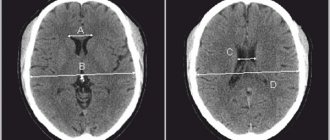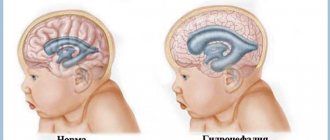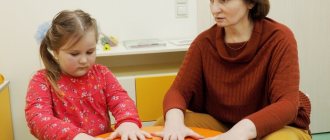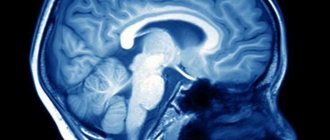Residual cerebral encephalopathy (RE) is a pathological condition caused by organic changes in cerebral structures against the background of ischemia, infections, injuries and other lesions. The severity ranges from minor impairments to severe neurological deficits that cause disability. The most common symptoms are headaches, paresis, autonomic dysfunction, and loss of consciousness. Intellectual and emotional disorders are possible.
To schedule a consultation, contact our operator by phone 8(969)060-93-93.
Causes
The etiology of EC in children and adults varies, but the underlying cause is always damage to brain tissue. In patients of younger age groups, the disease is most often associated with insufficient blood supply to the brain during gestation, during childbirth and in the first days after birth. The congenital form is provoked by factors such as intrauterine hypoxia, complications during childbirth, birth injuries, and the use of obstetric aids. Heredity, the presence of bad habits in the mother and the age of the pregnant woman play a certain role.
The list of factors that provoke RE in adult patients includes the following conditions:
- chemical dependencies: alcoholism, drug addiction;
- poisoning: salts of heavy metals, insecticides, other toxic substances, often as part of industrial hazards;
- radiation exposure;
- traumatic brain injuries;
- ischemic and hemorrhagic strokes, vascular thrombosis, hypertensive crises;
- cerebral atherosclerosis;
- infectious and inflammatory diseases of the membranes and tissues of the brain: meningitis, arachnoiditis, encephalitis;
- abnormalities in the development of brain structures and cerebral vessels;
- conditions after neurosurgical operations.
Determining the cause of the pathology is associated with some difficulties, since symptoms often appear many years after the adverse effect. In old age, the consequences of injury or infection may be superimposed by hypertension and atherosclerosis.
Symptoms
Manifestations are characterized by significant variability, their nature and severity depend on the prevalence and severity of damage to nerve cells, the compensatory capabilities of the brain and the age of the patient. In infants, signs of encephalopathy of residual origin are increased or decreased muscle tone, unmotivated crying, lack of response to stimuli, or, conversely, frequent episodes of restlessness.
As the child grows, mental retardation, delayed speech development and motor skills are added to the listed symptoms. The presence of such manifestations with sufficient probability indicates the prospect of persistence of residual phenomena throughout life. It should be taken into account that the clinical picture does not always correlate with the severity of brain dysfunction; some signs disappear over time or are eliminated with the help of therapeutic measures.
Subsequently, residual phenomena such as emotional disorders and delayed psychomotor development come to the fore. Children sleep poorly and are characterized by increased tearfulness and irritability. Long-term consequences of perinatal residual organic encephalopathy may include insufficient control over one’s behavior, attacks of aggression, fainting, nausea, vomiting, headache, autonomic dysfunction, poor memory, and decreased learning ability.
Manifestations of the disease can be combined into several neurological syndromes:
- Intellectual-mnestic. Occurs with cognitive impairment, attention and memory disorders.
- Astheno-neurotic. Weakness, increased fatigue, emotional instability, depressive and hypochondriacal tendencies are noted.
- Vestibular-coordinating. Accompanied by dizziness and poor coordination of movements.
- Cephalgic. There are severe headaches.
In adolescent and adult patients, residual encephalopathy may manifest itself as follows:
- frequent migraines that are difficult to relieve with traditional methods;
- emotional lability: apathy, hypochondria, sudden mood swings, causeless crying, increased anxiety, attacks of aggression;
- intracranial hypertension, manifested by headaches, nausea and vomiting;
- autonomic dysfunction: instability of blood pressure, increased or decreased heart rate, sweating;
- insomnia: difficulty falling asleep, frequent awakenings, daytime sleepiness;
- in severe cases - convulsions.
Clinical manifestations of encephalopathy on a residual organic background range from minor to pronounced. In most cases, especially with congenital anomalies, traumatic or inflammatory genesis of the pathology, signs of increased intracranial pressure come to the fore.
A common symptom is persistent cephalgia, peaking in the morning. Characteristic symptoms include nausea and vomiting at the height of a painful attack, weakness, fatigue, blurred vision or spots before the eyes, and difficulty performing intellectual work. Half of the patients have vestibular disorders. Sometimes a decrease in the accuracy of small movements is detected.
Features of children diagnosed with “residual encephalopathy of the brain”
Elena Savosina
Features of children diagnosed with “residual encephalopathy of the brain”
Residual encephalopathy (hereinafter referred to as REP)
of the brain is a pathology that develops due to the death of cells in the human central nervous system due to exposure to various damaging factors.
With REP, children suffer from chronic energy deficiency. The work cycles of their brain are reduced to 5-15 minutes, and relaxation pauses increase to 3-5 minutes or more. During periods of relaxation, the child’s “external” activity is not interrupted, but occurs automatically and is not consciously realized. At this time, the child does not perceive what is being said to him, although he seems to be listening attentively. If in a state of “relaxation” the child continues to write (as is usually the case in Russian language lessons), then the result of his work is classified as dysgraphia, since it is impossible to read what is written.
During relaxation breaks, children can continue to communicate and talk, but are unable to remember their statements. They can say something rude and be completely confident that they didn’t say anything like that. A child can take a pen from a neighbor’s table, put it in his pocket and not know that it is there. He may push or hit someone and not remember it. Listening to accusations against them, children with REP quite sincerely swear that they did not speak, did not take, did not push, and this causes even greater indignation among others. Since there are many witnesses to their misdeeds , they are often considered arrogant liars, hooligans and thieves. Children, on the contrary, come to the conclusion that those around them are unfair to them; it begins to seem to them that the whole world has turned against them.
Problems of self-government arise in a child with REP not only during periods of brain , but also when performing any activity in the working phase. The child acts immediately, impulsively and thoughtlessly. Therefore, the results of his actions are completely unexpected for him. The student first acts and only then understands what he has done. He tries to improve, but cannot keep his promises.
At a time when the brain “turns off” and “rests,” the child ceases to understand, comprehend and consciously process incoming information. It is not fixed anywhere and does not linger, so the child does not remember what he was doing at that time, does not notice, does not realize that there were any breaks in his work.
During a 40-minute lesson, he can “switch off” several times and let out a lot from the teacher’s story without noticing it. As a result, he either ceases to understand what is being discussed in the lesson, or in his head all this fragmentary information is randomly and uniquely combined, added together, which is what he takes away from the lesson. Often teachers and parents are puzzled by the absolutely incomprehensible, “wild” mistakes of children and are unable to find any reasonable explanation for them.
Recommendations for teachers teaching children diagnosed with REP of the brain :
1. During the learning process, it is necessary to free children from any secondary, auxiliary, non-essential, design work. Adults can mark the margins in the child’s notebook themselves and mark with a dot the place where they should start writing. It happens that a child diligently counts the cells that need to be moved from above and to the left, and in this search, making mistakes many times, he becomes so tired from the tension that, having finally found the place from which to write, he can no longer work at all.
2. Both general principles and specific methods proposed by Glen Doman are extremely effective. His approach is based on a clear structuring of the information that the child has to learn, dividing it into specific figurative units, with their subsequent organization into integral systems according to the laws that operate in the relevant field of knowledge. The unit of information must necessarily be a holistic, independent “image-fact” that is understandable to the child, can be comprehended by him and can be easily included in the system of his personal experience.
3. The systematic presentation of information creates a systematically organized memory, facilitates the search for necessary information, and develops thinking. This means that the load on attention and systematization of material when memorizing is significantly reduced. The form of information presentation should also be algorithmic and clear. Conciseness of wording, design, and illustrations must be observed, which should not contain anything superfluous, insignificant, or distracting.
4. Avoid situations that cause negative emotions. Negative emotions that arise when a child is unable to remember what is required force him to avoid “learning” situations. He no longer wants to listen or watch, so that later he does not have to suffer when answering questions. By requiring the exact reproduction of all information, we put the child in a situation of failure in advance and thereby destroy learning motivation. Naturally, strong negative emotions reduce the ability to learn in any person, especially in a child with REP of the brain . Therefore, it is naive to expect that he will perceive or understand anything better after he has been thoroughly scolded.
5. The classroom environment should be free and relaxed. You cannot demand the impossible from children : self-control and discipline are extremely difficult for a child with EBD. The child's sincere attempts to maintain discipline (sit correctly, not fidget, not talk, etc.)
and worries about the fact that this is not working out in any way lead even faster to overwork and loss
of performance . When attention is not focused on discipline, and lessons are conducted in a playful way, children behave calmer and work more productively. By allowing minor disciplinary violations, overall good performance .
6. If the teacher sees that the child has “switched off” and is sitting with a vacant gaze, then at this moment there is no need to touch him: the child will still not be able to respond rationally.
7. When conducting game lessons, you need to remember that strong and vivid emotional impressions can disorganize the activity of a student diagnosed with REP of the brain . Vivid emotions create something like hotbeds of excitement and can disrupt both subsequent activities and the results of previous ones.
Traditionally used methods of emotional inclusion in the lesson are also not suitable for children with REP of the brain Usually, in order for children to tune in, at the very beginning of the lesson it is proposed to tell them something interesting, although it has little to do with its essence.
One of the obstacles in the learning and intellectual development of children with REP of the brain is a peculiar protective form of activity that develops quite quickly in them. It is expressed in the fact that children try to do at least something (no matter what, even if they do not understand what and how to do. It is as a result of such protective activity that some absurd information, operations, i.e., get stuck in the student’s memory “information noise,” which further disorganizes their thinking and complicates learning.
Psychological and pedagogical support for children with EBD shows that even without treatment, as they grow older, there is always some normalization of brain . Even if attentiveness does not improve, the obvious “cyclicality” of intellectual activity is smoothed out, and “blackouts” occur less often. By the 5th-6th grade, children already feel the moment when “thoughts begin to run wild” and it becomes difficult to concentrate. They are distracted, rest and continue working when this condition passes. The total time during which they can study productively increases significantly.
Diagnostics
The diagnosis is made by a neurologist. It is often associated with significant difficulties due to the significant period between the causative disease and the time of manifestation of residual encephalopathy. A thorough collection of anamnesis and complaints, a comprehensive laboratory and instrumental examination are necessary. The list of hardware techniques includes EEG, MRI and CT of the brain. According to indications, a spinal puncture is performed, and genetic tests are performed to exclude hereditary provoking pathologies.
Complications
Complications of encephalopathy are associated with severe and irreversible damage to the brain and represent the extreme extent of the symptoms observed:
- loss of self-care ability due to motor or cognitive impairment;
- dementia: loss of knowledge and skills up to complete collapse of personality;
- loss of vision and hearing;
- severe mental disorders;
- convulsions;
- disturbances of consciousness: stupor, coma;
- death.
Cost of services
| CONSULTATIONS OF SPECIALISTS | |
| Initial consultation with a psychiatrist (60 min.) | 6,000 rub. |
| Repeated consultation | 5,000 rub. |
| Consultation with a psychiatrist-narcologist (60 min.) | 5,000 rub. |
| Consultation with a psychologist | 3,500 rub. |
| Consultation with Gromova E.V. (50 minutes) | 12,000 rub. |
| PSYCHOTHERAPY | |
| Psychotherapy (session) | 7,000 rub. |
| Psychotherapy (5 sessions) | 30,000 rub. |
| Psychotherapy (10 sessions) | 60,000 rub. |
| Group psychotherapy (3-7 people) | 3,500 rub. |
| Psychotherapy session with E.V. Gromova (50 minutes) | 12,000 rub. |
This list does not contain all prices for services provided by our clinic. The full price list can be found on the “Prices” , or by calling: 8(969)060-93-93. Initial consultation is FREE!
Treatment
Therapeutic measures must be comprehensive. Drug therapy is complemented by lifestyle correction. It is necessary to normalize the daily routine, alternating work and rest, sufficient time in the fresh air, and moderate physical activity. Physiotherapy and sanatorium-resort treatment are recommended, and sometimes psychotherapy is indicated. Medicines are prescribed taking into account the existing symptoms:
- cephalalgia: analgesics and NSAIDs;
- migraine: medications from the triptan group;
- dizziness: betaserc;
- insomnia, psychoemotional disorders: adaptogens, sleeping pills, antidepressants;
- intracranial hypertension: diuretics.
How to treat RE is determined individually. Patients are prescribed nootropics and nerometabolites. Children, along with symptomatic therapy, are given classes with a psychologist and a defectologist. The most important role is played by the participation of parents who support the baby and regularly work with him.
The forecast for the future is quite favorable. In most cases, with adequate complex therapy, it is possible to achieve the disappearance or significant reduction of symptoms. Patients lead normal lives: they study various professions, work, and build families. In severe cases, residual effects may persist, mainly headaches and autonomic disorders.
To make an appointment, just call tel. 8(969)060-93-93.
Treatment at the Energy of Health clinic
Doctors at the Health Energy Clinic are always ready to see patients of any age. We will conduct a thorough examination, identify possible causes of encephalopathy and take all measures to eliminate it:
- we will prescribe the most appropriate therapy, describe the course of treatment and the frequency of its repetition;
- We will carry out all the necessary manipulations (placement of a drip, intravenous and intramuscular injections) in the comfortable conditions of a day hospital and manipulation room;
- We will complement the therapy with modern physiotherapeutic procedures;
- We will conduct a massage course and prescribe exercise therapy for maximum effectiveness.
Our neurologists will monitor the patient’s condition and adjust treatment if necessary. Treatment of encephalopathy is a long and complex process, but we are ready to take on it.










